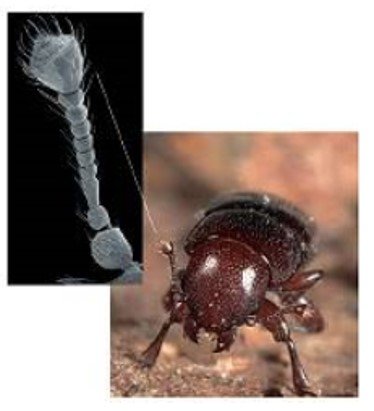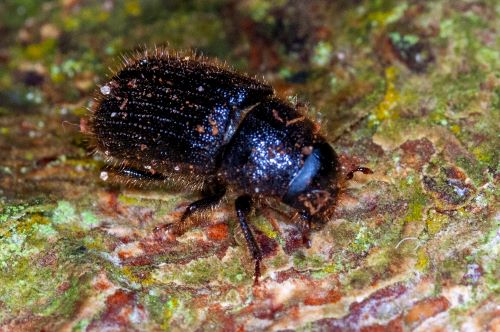Pest management of Dendroctonus micans
Our approach to management is to breed and release a host-specific predatory beetle, Rhizophagus grandis, that is found within the pest’s natural range.
Our approach to management is to breed and release a host-specific predatory beetle, Rhizophagus grandis, that is found within the pest’s natural range.
Our approach to management is to breed and release a host-specific predatory beetle, Rhizophagus grandis, that is found within the pest’s natural range. This strategy is known as ‘classical’ biological control.
The biological control programme has been, and continues to be highly successful because of the extraordinary ability of the predator to locate its prey even when there are only a few infested trees in the forest.

Rhizophagus grandis. Sense organs that detect chemical signals from prey are located on the antennae, one of which is magnified (inset).
The rearing system to breed R. grandis is efficient and flexible and each adult now costs around only £0.10 to rear for release. In addition, because R. grandis has an extremely well-developed ability to find its prey, together with a rapid reproductive rate, only small numbers of individuals are needed to control each new outbreak; typically around 25-50 adults per site.
In forestry, exotic bark beetles are a particular threat because they can be concealed in imported timber. The most damaging species tunnel to form galleries within the bark of living trees where their larvae feed and develop, ultimately killing the tree.

Adult Dendroctonus micans.
In Britain, the spruce bark beetle, Dendroctonus micans, is a well-established pest that was accidentally introduced from continental Europe in the 1970s. Spruce is our most important commercial tree species and managing this pest is a high priority.
For more information about this biological control for the management of Dendroctonus micans contact the NRS entomology department.
Additional information about Dendroctonus micans is available within our online pest and disease resources.
Further management information is also available at can be found in Practice Note 17: Minimising the impact of the great spruce bark beetle